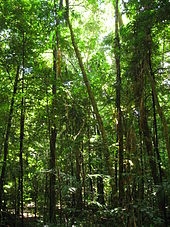Trees are not a monophyletic taxonomic group but consist of a wide variety of plant species that have independently evolved a trunk and branches as a way to tower above other plants to compete for sunlight.
Although "tree" is a common word, there is no universally recognised precise definition of what a tree is, either botanically or in common language.[1][2] In its broadest sense, a tree is any plant with the general form of an elongated stem, or trunk, which supports the photosynthetic leaves or branches at some distance above the ground.[3] Trees are also typically defined by height,[4] with smaller plants from 0.5 to 10 m (1.6 to 32.8 ft) being called shrubs,[5] so the minimum height of a tree is only loosely defined.[4] Large herbaceous plants such as papaya and bananas are trees in this broad sense.
Overview
The tree growth habit is an evolutionary adaptation found in different groups of plants: by growing taller, trees are able to compete better for sunlight.[14] Trees tend to be tall and long-lived,[15] some reaching several thousand years old.[16] Several trees are among the oldest organisms now living.[17] Trees have modified structures such as thicker stems composed of specialised cells that add structural strength and durability, allowing them to grow taller than many other plants and to spread out their foliage. They differ from shrubs, which have a similar growth form, by usually growing larger and having a single main stem;[5] but there is no consistent distinction between a tree and a shrub,[18] made more confusing by the fact that trees may be reduced in size under harsher environmental conditions such as on mountains and subarctic areas. The tree form has evolved separately in unrelated classes of plants in response to similar environmental challenges, making it a classic example of parallel evolution. With an estimated 60,000-100,000 species, the number of trees worldwide might total twenty-five per cent of all living plant species.[19][20] The greatest number of these grow in tropical regions; many of these areas have not yet been fully surveyed by botanists, making tree diversity and ranges poorly known.
Distribution
 The Daintree Rainforest
The Daintree Rainforest The number of trees in the world, according to a 2015 estimate, is 3.04 trillion, of which 1.39 trillion (46%) are in the tropics or sub-tropics, 0.61 trillion (20%) in the temperate zones, and 0.74 trillion (24%) in the coniferous boreal forests. The estimate is about eight times higher than previous estimates, and is based on tree densities measured on over 400,000 plots. It remains subject to a wide margin of error, not least because the samples are mainly from Europe and North America. The estimate suggests that about 15 billion trees are cut down annually and about 5 billion are planted. In the 12,000 years since the start of human agriculture, the number of trees worldwide has decreased by 46%.[34][35][36][37] There are approximately 64,100 known tree species in the world. With 43% of all tree species, South America has the highest biodiversity, followed by Eurasia (22%), Africa (16%), North America (15%), and Oceania (11%).
The main parts of a tree include12:
- Roots: The underground system that anchors the tree and absorbs water and nutrients.
- Crown: The upper part of the tree composed of leaves, twigs, branches, flowers, and fruit.
- Trunk: The central, usually upright, wood part of the tree.
- Leaves: The primary location for photosynthesis.
- Flowers: The site of reproduction.
Here are some key points about trees :
- Trees are woody plants that regularly renew their growth.
- They have a single self-supporting trunk containing woody tissues.
- Most species have secondary limbs called branches.
- Trees can live for many years, with some being thousands of years old.
- There are over 60,000 tree species worldwide. THANK YOU

